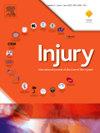Osseointegration for transfemoral amputees: Influence of femur length and implant sizing on bone-implant contact and alignment
IF 2.2
3区 医学
Q3 CRITICAL CARE MEDICINE
Injury-International Journal of the Care of the Injured
Pub Date : 2025-01-17
DOI:10.1016/j.injury.2025.112162
引用次数: 0
Abstract
Introduction
Clinical data on osseointegration (OI) for limb replacement indicates a concerning increase in mechanical complications after five years post-implantation. Since adequate bone-implant contact and proper implant alignment are critical factors for successful osseointegration, it is essential to identify the factors influencing these outcomes. This study aimed to assess the effects of residual femur length and implant sizing on bone-implant contact and implant alignment.
Methods
Three-dimensional models of eight cadaveric femora were reconstructed from CT scans, and transfemoral amputations were simulated for each femur at three levels: short (ST: 1/3 L), medium (MD: 1/2 L), and long (LG: 2/3 L). Virtual OI surgeries were then performed using computer-aided design (CAD) models, and implant sizes were recorded. Subsequently, the effect of implant sizing was assessed by adjusting the implant size by ±1 mm. Contact length and implant alignment were compared between the groups using repeated measures analysis of variance with Bonferroni correction.
Results
The contact in the ST group (65.2 ± 7.3 %) was significantly less compared to the MD (96.1 ± 4.1 %, p < 0.001) and LG (96.8 ± 3.2 %, p < 0.001) groups. Upsizing increased contact in the ST group by 7.0 ± 2.6 % (p < 0.001), though it did not reach levels comparable to the MD and LG groups (p > 0.05). Additionally, sagittal implant misalignment was larger in the ST group (10.1 ± 2.0°) than in the MD (7.9 ± 1.5°) and LG (3.5 ± 1.6°) groups (p < 0.001), while no difference was observed in coronal implant alignment.
Conclusion
These findings highlight the factors influencing mechanical complications of osseointegration implants and provide a basis for refined implant designs and surgical techniques for patients with short residual limbs.
求助全文
约1分钟内获得全文
求助全文
来源期刊
CiteScore
4.00
自引率
8.00%
发文量
699
审稿时长
96 days
期刊介绍:
Injury was founded in 1969 and is an international journal dealing with all aspects of trauma care and accident surgery. Our primary aim is to facilitate the exchange of ideas, techniques and information among all members of the trauma team.

 求助内容:
求助内容: 应助结果提醒方式:
应助结果提醒方式:


